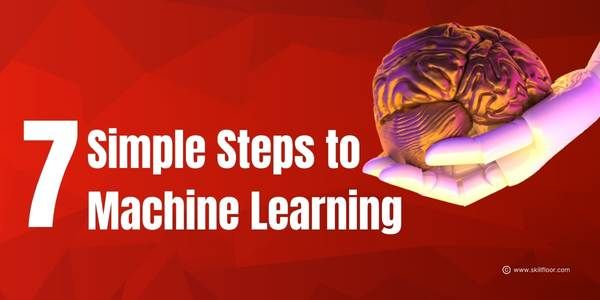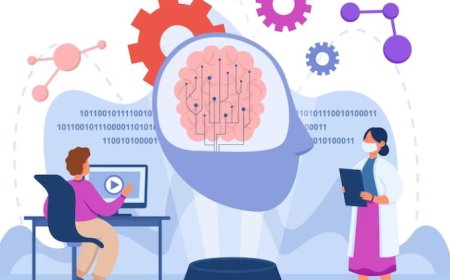The 7 Crucial Steps in Machine Learning
The 7 crucial steps in machine learning, from defining problems to model deployment, for successful and efficient outcomes.

Machine learning is changing industries, and I've had the opportunity to witness it firsthand. I previously had a job with a company that was having trouble retaining clients. Through data pattern analysis, we were able to pinpoint the main causes of client attrition, which enabled the team to take prompt, efficient action.
The process of machine learning is intricate and involves more than simply entering data into a system. Every stage, from choosing pertinent data to testing and improving models, is essential. Because it creates dependable, efficient models, industry professionals stress the need for a systematic approach. These tried-and-true methods help businesses handle real-world issues with significant, long-lasting effects.
When creating a machine learning model, each step is crucial. I've witnessed initiatives falter or fail due to the omission of important phases. In order to succeed in machine learning, one must adhere to a tried-and-true methodology that guarantees enduring, dependable outcomes and positions initiatives for long-term influence.
What is Machine Learning?
Machine Learning (ML) is a type of technology that allows computers to learn from data and make decisions or predictions without being explicitly programmed for every single task. An ML model uses patterns in data to "learn" how to make judgments or predictions on its own, rather than according to predetermined guidelines.
For example, ML is used in applications like:
-
Recommendation systems (suggesting movies or products based on past choices)
-
Image recognition (identifying faces in photos or detecting objects)
-
Language processing (understanding and translating spoken or written language)
-
Predictive analytics (forecasting trends in areas like finance or healthcare)
Fundamentally, machine learning (ML) is putting vast volumes of data into algorithms that identify links and patterns, which the model may then utilize to forecast fresh data. The model frequently becomes better over time as it receives more data, becoming more precise and efficient.
The Importance of Machine Learning
-
Automation of Tasks: Businesses may save time and concentrate on more complicated activities, like improving customer service or product quality, by using machine learning to automate repetitive processes.
-
Better Decision-Making: ML's data analysis enables businesses to make smarter decisions more rapidly. It aids medical picture analysis, enabling early illness detection and better patient treatment.
-
Personalization: ML makes interactions more relevant by learning from user behavior and customizing experiences. In order to increase user involvement, this offers tailored suggestions for music, movies, or shopping.
-
Improved Efficiency and Productivity: By seeing trends and anticipating requirements, machine learning helps organizations in streamlining procedures. It can even forecast equipment problems in manufacturing, which lowers expenses and downtime.
-
Handling Complex Data: ML performs exceptionally well with unstructured data, such as audio, video, and photos. Real-time data processing is crucial for safety in technologies like autonomous driving.
-
Constantly Evolving Technology: With more data, machine learning models get better, adjust to changes, and become more accurate over time, keeping technology and organizations abreast of emerging trends. Becoming a Certified Machine Learning Professional can be a key asset in applying these advanced capabilities effectively.
Types of Machine Learning
1. Supervised Learning
Labeled data, or input data with known results, is used to train the model in supervised learning. It is frequently used for jobs like email spam detection, where each email is classified as spam or not, and learns to make predictions based on trends.
2. Unsupervised Learning
Unsupervised learning works with unlabeled data, in which the model looks for hidden groups or patterns without any predetermined results. It's frequently used for clustering, such as putting clients in groups based on comparable buying patterns.
3. Semi-Supervised Learning
Labeled and unlabeled data are combined in semi-supervised learning. In medical imaging, where labeled data may be scarce but is complemented by larger sets of unlabeled data, it uses a lesser quantity of labeled data to direct the learning process.
4. Reinforcement Learning
Reinforcement learning involves the model interacting with the environment and getting feedback (in the form of rewards or penalties) according to its behavior. It is employed in robotics and gaming, where the model is always learning to make better choices.
Applications of Machine Learning
1. Recommendation Systems
Social networking, online retail sites, and streaming services all employ recommendation engines driven by machine learning. By recommending pertinent relationships, goods, or material, it personalized user experiences and raises pleasure and engagement.
2. Healthcare Diagnosis
Machine learning models are used in the healthcare industry to evaluate genetic information, patient histories, and medical imaging in order to help with early identification of diseases like cancer and heart disease. This helps doctors give prompt therapies and increases diagnostic accuracy, which might save lives.
3. Financial Fraud Detection
By examining transaction patterns, Machine Learning in Finance is essential for spotting and stopping fraud. By instantly identifying anomalous activity, it safeguards clients and reduces losses for banks and companies.
4. Autonomous Vehicles
Machine learning is used by self-driving cars to evaluate data from radars, cameras, and sensors. In order to maneuver safely, identify impediments, and react to road conditions, ML models assist cars in making snap judgments.
5. Natural Language Processing (NLP)
ML is used by NLP systems, such as voice assistants, chatbots, and language translators, to comprehend and process human language. By enhancing human-device connection, this technology facilitates more seamless and intuitive digital interactions.
6. Predictive Maintenance
By examining usage and performance data, machine learning forecasts equipment failures in sectors such as manufacturing. This makes preventive maintenance possible, which lowers maintenance expenses for companies and decreases downtime.
Advantages and Disadvantages of Machine Learning
|
Advantages of Machine Learning |
Disadvantages of Machine Learning |
|---|---|
|
Enhances Accuracy Over Time: ML models improve with more data, leading to greater accuracy in predictions. |
High Development Costs: Developing and maintaining ML models can be costly due to the need for skilled professionals and advanced hardware. |
|
Supports Real-Time Decision Making: ML can analyze data instantly, helping businesses respond to changes quickly. |
Requires Large Amounts of Data: ML models need extensive, quality data to perform well; limited data can reduce effectiveness. |
|
Drives Innovation: ML enables groundbreaking technologies like autonomous vehicles and personalized medicine, pushing industry boundaries. |
Complex Setup and Maintenance: Setting up ML models and keeping them updated requires ongoing attention to ensure accuracy and relevance. |
|
Improves Customer Experience: By analyzing user behavior, ML allows for personalized experiences, leading to greater satisfaction and loyalty. |
Can Amplify Biases: If the data includes biases, ML may replicate or worsen them, leading to unfair outcomes. |
|
Enables Predictive Maintenance: ML helps predict equipment failures, reducing downtime and boosting operational efficiency. |
Lack of Transparency: Some ML models are “black boxes,” making it hard to understand the reasoning behind certain predictions. |
|
Enhances Security: ML can detect threats or anomalies in cybersecurity, helping prevent unauthorized access and data breaches. |
Potential Ethical Concerns: Misuse of ML in areas like surveillance or biased decision-making can lead to privacy and ethical issues. |
7 Key Steps in Machine Learning
1. Clearly Defining the Problem
Having a precise problem definition helps you stay focused on your project, much like a roadmap. For instance, knowing your goal will help you select the appropriate data and model if your objective is to forecast consumer sales.
Key Tips for Defining Your Problem
-
Be Specific: Instead of saying, “I want to predict customer behavior,” you could say, “I want to predict which customers are most likely to buy a specific product.”
-
Think About Impact: Think about how resolving this issue will affect your work. It might not be worthwhile to pursue the solution if it will not aid in your decision-making.
-
Frame the Problem with Input and Output: Thinking about the data you will enter into the model (input) and the results you hope to obtain (output) is necessary for this.
2. Collecting Data
Data collection is essential to every endeavor. Building accurate models is aided by high-quality data. Collect information from trustworthy sources, make sure it's pertinent, and confirm that it accurately reflects the issue you're trying to solve.
Types of Data Sources
-
Existing Databases: Frequently, businesses already have a lot of data on file, such as feedback forms, sales records, and client information.
-
Surveys and Questionnaires: You can generate the data you require if you don't already have it by using questionnaires or surveys to get new data.
-
Online Sources: Online data that is publicly available can occasionally be found as part of the Steps in Machine Learning. There are open data platforms where users can exchange potentially helpful datasets.
Key Tips for Data Collection
-
Quality Over Quantity: It’s better to have a smaller amount of high-quality data than a large amount of messy data.
-
Check for Bias: Make sure your data isn't biased toward any one result as part of the Steps in Machine Learning. Include information from different client kinds, for instance, if you're gathering data on customer purchases.
-
Be Ethical: Always make sure you have permission to use data and that you’re respecting people’s privacy.
3. Data Cleaning and Preprocessing
Basic Steps in Data Cleaning
-
Remove Duplicates: Make sure you’re not counting the same information twice.
-
Handle Missing Values: Handle missing data by either deleting those rows or filling in values based on comparable data points as part of the Steps in Machine Learning.
-
Standardize Formats: Make sure the format of all your data is the same. For instance, standardize dates to a single format if they exist in many forms.
Basic Steps in Data Preprocessing
-
Scaling: This entails bringing the values of several aspects into line with one another. When using techniques that are sensitive to feature size, it is frequently done to enhance model performance.
-
Encoding: To help the model understand non-numeric data (such as "yes" or "no"), turn it into numerical values as part of the Steps in Machine Learning process.
-
Feature Selection: Select which data features are most essential to incorporate into your model. A model that has too many extra features may become sluggish and complex.
4. Feature Engineering
Key Tips for Feature Engineering
-
Use Simple Transformations First: Before advancing to more intricate feature engineering, start with simple feature combinations and evaluate their effectiveness.
-
Test Different Features: Not all of the features will be helpful. To determine whether characteristics genuinely increase model accuracy, experiment with different features using techniques like cross-validation.
-
Monitor Feature Impact: Regularly assess each feature's significance as one of the steps in machine learning. In this way, you may retain just the features that actually provide value to your model.
Examples of Feature Engineering
-
Combining Features: Combining two pieces of data can occasionally result in a new, helpful feature. For example, you might develop a "view-to-purchase ratio" function if you have information on how many goods a user views and how many they buy.
-
Time-Based Features: Creating features that reflect time periods (such as the day of the week or season) might be useful if you're forecasting something that fluctuates over time, like stock prices.
-
Domain-Specific Knowledge: Utilize your expertise in your sector to develop features that make sense. For instance, you may develop a feature for "distance to the nearest school" if you're examining housing costs.

5. Model Selection
Common Model Types
-
Linear Models: Simple yet efficient, particularly with uncomplicated data. Logistic regression (for binary classification) and linear regression (for numerical value prediction) are two examples.
-
Decision Trees and Random Forests: Good for handling complex, non-linear data and often easier to interpret.
-
Neural Networks: Strong in managing intricate patterns, particularly in words or visuals. But they need more information and processing power.
Key Tips for Model Selection
-
Consider the Problem Type: Consider the project's requirements while selecting models. Classification models, for instance, are often successful in making category predictions.
-
Start Simple: Start with basic models and test more complicated ones only, when necessary, in the first steps in machine learning. Simple models frequently provide outstanding outcomes.
-
Evaluate Model Speed and Resources: More processing power and time are needed for complex models. Using simpler models can save effort and yet yield good results if resources are limited.
6. Model Training and Evaluation
Basic Steps in Model Training and Evaluation
-
Split the Data: Separate your dataset into training and testing sets (usually 80% training and 20% testing) so that the model may be successfully tested on raw data.
-
Train the Model: Utilize the training set to assist the model in discovering correlations and patterns so that it can provide precise predictions on fresh data.
-
Cross-Validation and Evaluation: Utilize measures like accuracy and precision to evaluate performance and apply cross-validation by splitting data across several "folds" to guarantee consistency.
Key Tips for Model Training and Evaluation
-
Choose the Right Metrics: Your problem will determine which metric is optimal. For example, great recall could be more important in Risk Management than precision.
-
Watch for Overfitting: Watching for overfitting is one of the most important steps in machine learning. Try simpler models or regularization strategies if your model performs well on training data but poorly on test data.
-
Iterate and Improve: After testing, make any necessary model refinements. To increase accuracy and outcomes, experiment with other strategies, tweak characteristics, or fine-tune settings.
7. Model Deployment and Monitoring
Basic Steps in Model Deployment
-
Set Up a Deployment Environment: This may be a web application, a cloud service, or a corporate server. Select a setting where your model can generate predictions in real time.
-
Integrate with Existing Systems: Make sure that the model's outputs integrate seamlessly with other systems (for example, a recommendation engine receiving predictions from an e-commerce model).
-
Test the Model in Production: To make sure the model works as intended and is compatible with your system, run it first in a controlled setting.
Monitoring and Maintenance
-
Track Model Performance: To evaluate any changes in quality over time, keep an eye on important performance indicators like accuracy or mistake rates.
-
Handle Data Drift: Addressing "data drift" is one of the crucial steps in machine learning. Retrain the model frequently using fresh data to keep it accurate and current.
-
Establish a Feedback Loop: Obtain input from practical application, which may assist in continually enhancing the model in light of real results and performance.
Key Tips for Model Deployment and Monitoring
-
Automate Monitoring: Configure automatic alerts to let you know if the model's performance declines so you may take swift action.
-
Plan for Retraining: To maintain accuracy, add fresh data to the model on a regular basis, particularly if data patterns shift.
-
Document Everything: Maintain track of the model's settings, data sources, and changes. If you need to troubleshoot, this documentation will help you keep track of changes.
How Machine Learning Will Transform the Future
Our environment is undergoing significant change as a result of machine learning. It helps physicians identify illnesses early and provide tailored therapies in the healthcare industry, and it enhances risk management and fraud detection in the financial sector. Transportation will become safer and more effective thanks to the steps in machine learning that enable self-driving cars, intelligent traffic systems, and predictive models.
Through resource management and climate trend prediction, machine learning enhances daily living and promotes sustainability in everything from personalized education to customized purchasing. Industries are getting ready for the future of machine learning, which promises a smarter, more connected, and responsive world to our individual requirements, by adhering to fundamental steps in machine learning.
Many sectors are undergoing significant transformation as a result of machine learning, which is producing more intelligent and individualized solutions. Data gathering, model selection, and continuous monitoring are all crucial steps in machine learning that help us create models that successfully solve problems in the real world. Every stage contributes to precise, flexible solutions that can change as new information becomes available. By taking these steps in machine learning, we're opening the door to technology that can adapt to the demands of each individual, encouraging creativity, productivity, and a more interconnected future in the fields of healthcare, finance, transportation, and more.






























































